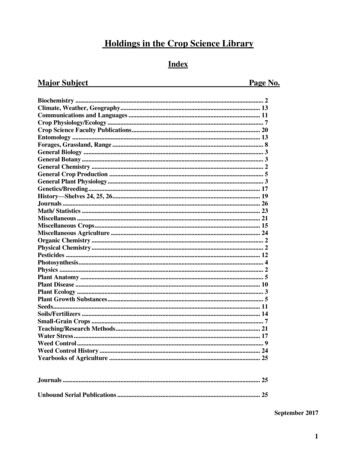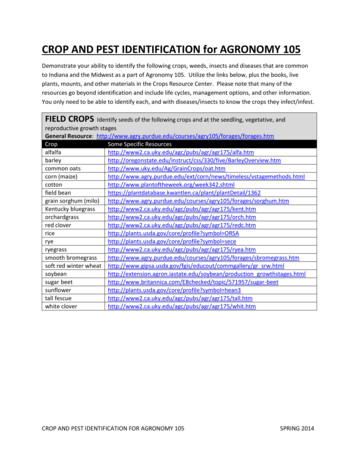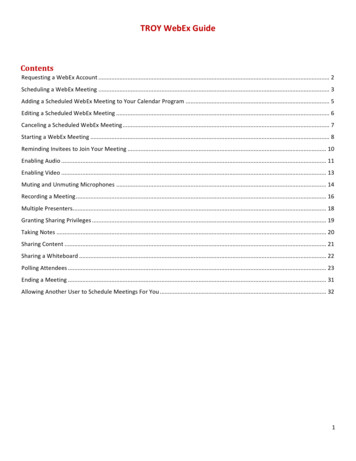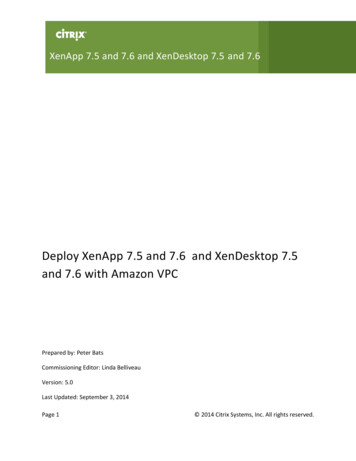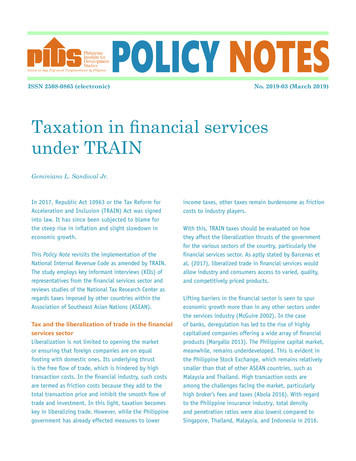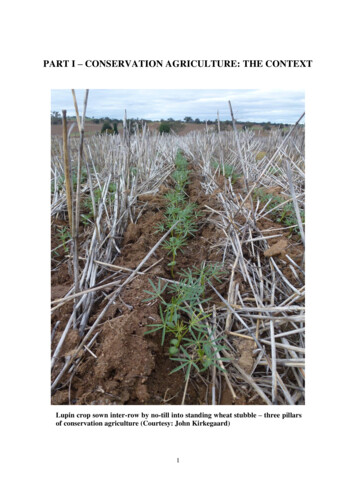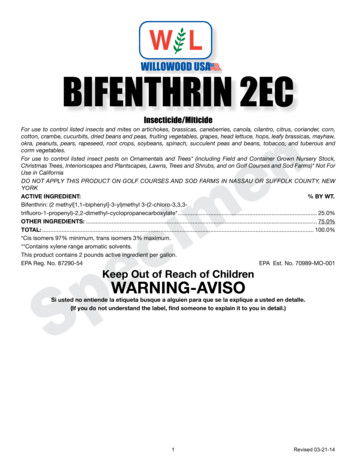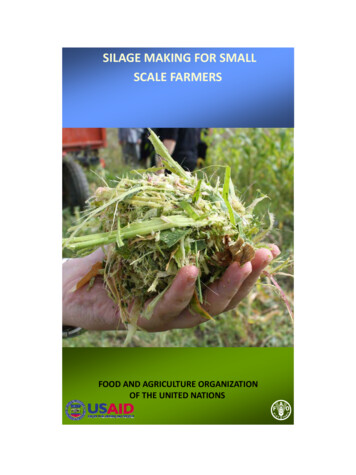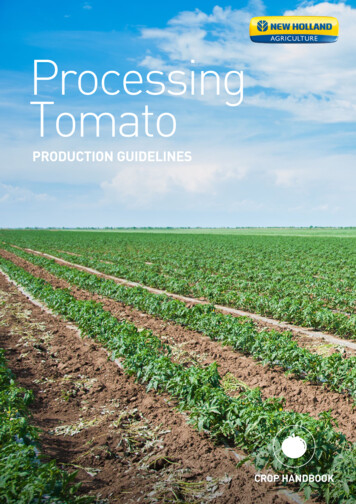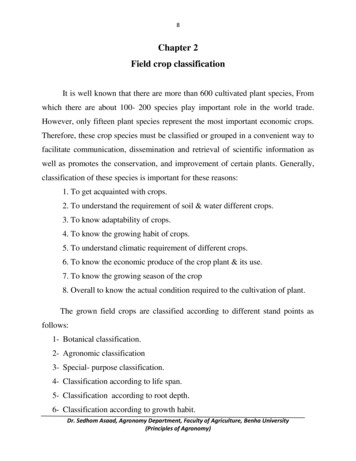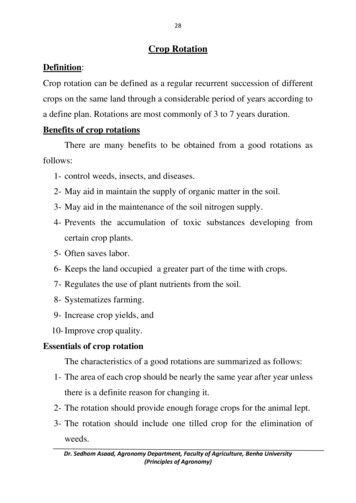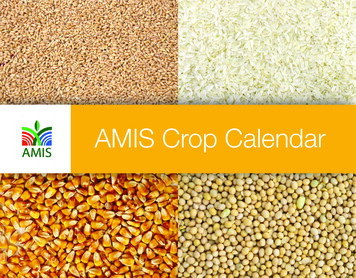
Transcription
AMIS Crop Calendar
AMIS Crop Calendar
First published 2012 by the Mexican Agri-food and Fishery Information Service, partof the Ministry of Agriculture, Livestock, Rural Development, Fisheries and Food(SAGARPA), in collaboration with The Agricultural Market Information System (AMIS).Benjamin Franklin 146, Miguel Hidalgo, Mexico D.F. 11800,www.siap.gob.mx. AMIS 2012. All rights reserved.
Food and Agriculture Organizationof the United NationsOrganisation for Economic Cooperation and DevelopmentWorld BankInternational Food PolicyResearch InstituteInternational Fund forAgricultural DevelopmentUnited Nations Conference onTrade and DevelopmentUN High-level Task Force onthe Food Security CrisisInternational Grains CouncilWorld Food ProgrammeWorld Trade Organization
ContentsForewordCropsWheatRiceMaizeSoybeans
Foreword
The Agricultural Market Information System (AMIS) is a G20 initiativeto enhance food market transparency and encourage coordination ofpolicy action in response to market uncertainty.The initial focus of AMIS is on four crops that are particularly importantin international food markets, namely wheat, maize, rice and soybeans.AMIS seeks to strengthen collaboration and dialogue among main producing, exporting and importing countries.About this calendarThe monitoring of global markets requires a close watch of crop development in each country/region during the growing season. It is for thisreason that an easy-to-use crop calendar covering the most importantproducing countries could be a valuable tool for market analysis.This document was produced with the collaboration of the MexicanAgri-food and Fishery Information Service, which is part of the Ministry of Agriculture, Livestock, Rural Development, Fisheries and Food(SAGARPA), during the Mexican Presidency of the G20 Group.
AMIS Participating CountriesThe countries included in this calendar are those taking part in the AMIS initiative, thatis the G-20 countries plus Spain, along with the seven invited participating countries(Egypt, Kazakhstan, Nigeria, the Philippines, Thailand, Ukraine and Viet Nam).Overall AMIS countries account for the bulk of production and exports of the four cropscurrently covered under the initiative.
Crops
WheatIts origin can be traced back to at least 11 000 years ago in theNile Delta and Mesopotamia. There are several domesticated wheatvarieties, including hybrids, but most often, the distinction is madebetween soft and hard (durum) wheat.Soft wheat is by far the most important for production. It is usedfor food preparations, but lower quality supplies are commonlydestined to feed and, in recent years, also for the production ofbio-ethanol.Hard/durum wheat, the production of which is far smaller than thatof soft wheat, is largely used as ingredient for producing semolinaand pasta. A number of countries grow two wheat crops per year:the winter wheat and spring wheat crops, named after the period oftheir planting.
Wheat productionGlobal production of wheat averaged 680 million tonnes in 2009-2011, with close to half of the world outputcoming from the EU, China and India. Overall AMIS countries accounted for 87 percent of the total. About 132percent were exported by AMIS countries. AMIS countries accounted for a much smaller share of world wheatimports, of 49 percent.Top 10 wheat producing countries(2009-2011 average)Wheat production(2009-2011 average)13%87%Non-AMISAMIS
Wheat exportsWheat exports(2009-2011 average)Top 10 wheat exporting countries(2009-2011 average)3%97%Non-AMISAMIS
Wheat importsTop 10 wheat importing countries(2009-2011 average)Wheat imports(2009-2011 average)51%49%Non-AMISAMIS
WHEAT: planting and harvesting calendarPlanting and Harvesting periods are not pictured for countries where production is nil or negligible.PlantingHarvesting
WHEAT: planting and harvesting calendarPlanting and Harvesting periods are not pictured for countries where production is nil or negligible.PlantingHarvesting
WHEAT: planting and harvesting HPHHHHPPPP PlantingH HarvestingAMIS participating countriesRest of the world
WHEAT: planting and harvesting HHHHHHHHHHHHHHHHHHPPPPP PlantingH HarvestingAMIS participating countriesRest of the world
WHEAT: planting and harvesting PHHHHNovemberDecemberPPPPPPPPPHHHHHP PlantingH HarvestingHHAMIS participating countriesRest of the world
RiceRice is a cereal grain thought to have originated in the Yangtze River valley in China where it was domesticated at least 10 000 yearsmajor continents under a wide range of ecologies and climates.Rice is mainly an annual crop, even though it may survive as a perennial.itates fertilization and reduces the incidence of weeds and pestplants. More than one rice crop may be cultivated every season,especially under the tropical and sub-tropical climates.There are two major rice varieties grown, Indica and Japonica, butpopular strains also include Basmati, Hom Mali and other aromaticrices. Despite its migration to other regions, Asia remains the hubof rice production, with many countries in the region growing morethan one crop per season. Rice is principally a food commodity,with only few countries diverting supplies to feed or industrialuses.
Rice productionGlobal production of rice averaged 469 million tonnes in 2009-2011, in milled rice equivalent, with more thanhalf concentrated in China and India. Overall, AMIS countries accounted for 78 percent of the total. About 32million tonnes of rice were traded internationally in the same period, 78 percent of which were exported byAMIS countries. On the other hand, AMIS countries accounted for only 43 percent of world rice imports.Top 10 rice producing countries(2009-2011 average)Rice production (milled)(2009-2011 average)22%78%Non-AMISAMIS
Rice exportsTop 10 rice exporting countries(2009-2011 average)Rice exports(2009-2011 average)21%79%Non-AMISAMIS
Rice importsTop 10 rice importing countries(2009-2011 average)Rice imports(2009-2011 average)57%43%Non-AMISAMIS
RICE: planting and harvesting calendarPlanting and Harvesting periods are not pictured for countries where production is nil or negligible.PlantingHarvesting
RICE: planting and harvesting calendarPlanting and Harvesting periods are not pictured for countries where production is nil or negligible.PlantingHarvesting
RICE: planting and harvesting rilPPPPPPPPPHHHPPHPHHHPHPHHPHHHHP PlantingPPHHH HarvestingAMIS participating countriesRest of the world
RICE: planting and harvesting HJulyAugustHHPPPHHHPPPPHPHHHPHPPPHPHHPHPHPP PlantingH HarvestingAMIS participating countriesRest of the world
RICE: planting and harvesting PHPHHHHHPPPPPP PlantingH HarvestingAMIS participating countriesRest of the world
MaizeMaize (also known as corn) is a cereal grain, believed to have been domesticated at least 7 000 years ago whenit was grown in Central Mexico. Maize is an annual plant with high productivity and exceptional geographicis generally categorized into two broad groups: yellow maize and white maize, depending on their colour andtaste. Yellow maize constitutes the bulk of world production and international trade. It is grown in northernhemisphere countries where it is traditionally used for animal feed. In addition, maize has a wide range of industrial applications, including the production of ethanol. White maize cultivation, which requires more favourableclimatic conditions than yellow maize, is mainly produced in the United States, Mexico and in a few countriesground in recent years and now represent an important share of overall production.
Maize productionGlobal production of maize averaged 853 million tonnes in 2009-2011, with more than half concentrated in theUnited States of America and China. Overall, AMIS countries accounted for 91 percent of the total. About 96million tonnes of maize were traded internationally in the same period, 93 percent of which were exported byAMIS countries. On the other hand, AMIS countries accounted for about 59 percent of world maize imports.Top 10 maize producing countries(2009-2011 average)Maize production(2009-2011 average)9%91%Non-AMISAMIS
Maize exportsTop 10 maize exporting countries(2009-2011 average)Maize exports(2009-2001 average)7%93%Non-AMISAMIS
Maize importsTop 10 maize importing countries(2009-2011 average)Maize imports(2009-2011 average)41%59%Non-AMISAMIS
MAIZE: planting and harvesting calendarPlanting and Harvesting periods are not pictured for countries where production is nil or negligible.PlantingHarvesting
MAIZE: planting and harvesting calendarPlanting and Harvesting periods are not pictured for countries where production is nil or negligible.PlantingHarvesting
MAIZE: planting and harvesting ilPPPPPPPPPPHHHHPHPHHPPPPHHPHHHHHHP PlantingHHHH HarvestingAMIS participating countriesRest of the world
MAIZE: planting and harvesting JulyAugustHHPHHPPPHPHHHPHHHPPHHPP PlantingH HarvestingAMIS participating countriesRest of the world
MAIZE: planting and harvesting HHPPPPPPPPP PlantingH HarvestingAMIS participating countriesRest of the world
Soybeanses to the crop have been found in China around 3 000 years ago.plant, and for the production of fermented food products. Until fairlyrecently, cultivation was limited largely to Asian countries and onlygained popularity in the America and Europe in the early 1900s.Although in some countries soybeans are transformed at the locallevel into food products for direct human consumption, much of today’s production is crushed at industrial scale to obtain soybean oiland soybean meal, which, respectively, account for about one thirdand two thirds of the crop’s economic value. Soy-oil and soy-mealare consumed worldwide as food and animal feedstuff respectively.In recent years, soybean oil also started to be used for the production of bio-diesel.creased fast in recent years, with important implications for consumption and trade.
Soybeans productionGlobal soybean production averaged 254 million tonnes in 2009-2011. Production is highly concentrated, withsome 80 percent originating in three countries alone, the United States of America, Brazil and Argentina. Asa group, AMIS countries account for 95 percent of world production. Out of today’s global soybean trade ofaround 92 million tonnes, AMIS countries account for about 93 percent of world exports and 90 percent of global imports.Top 10 soybeans producing countries(2009-2011 average)Soybeans production(2009-2011 average)95%5%Non-AMISAMIS
Soybeans exportsTop 10 soybeans exporting countries(2009-2011 average)Soybeans exports(2009-2011 average)7%93%Non-AMISAMIS
Soybeans importsTop 10 soybeans importing countries(2009-2011 average)Soybeans imports(2009-2011 average)10%90%Non-AMISAMIS
SOYBEANS: planting and harvesting calendarPlanting and Harvesting periods are not pictured for countries where production is nil or negligible.PlantingHarvesting
SOYBEANS: planting and harvesting calendarPlanting and Harvesting periods are not pictured for countries where production is nil or negligible.PlantingHarvesting
SOYBEANS: planting and harvesting PPPPPHHHPHHHHHHHHP PlantingH HarvestingAMIS participating countriesRest of the world
SOYBEANS: planting and harvesting AugustHPPPHPH HarvestingHHPP PlantingPPHHHPAMIS participating countriesRest of the world
SOYBEANS: planting and harvesting HHHHHHPPPPPNovemberDecemberHHHHHHHPHHHHHPPPPP PlantingPPPPHPPPH HarvestingAMIS participating countriesRest of the world
Despite its migration to other regions, Asia remains the hub of rice production, with many countries in the region growing more than one crop per season. Rice is principally a food commodity, with only few countries diverting supplies to feed or industrial uses. Global production of rice ave
